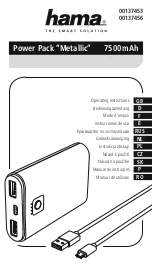
•
Clean off any dirt, rust or paint on the part you wish to solder
with the supplied tools.
•
Heat the part with the soldering iron.
•
Apply rosin-based solder to the part and melt it with the
soldering iron.
Note:
If using non-rosin based solder, ensure you apply a
soldering paste to the part before applying the solder.
Wait for the solder to cool and harden before moving the soldered part.
Note:
A soldering sponge is recommended, lightly dampened with water before use.
Before soldering, clean the tip on the sponge and then tin the tip with fresh solder. Do
not use the sponge dry.
•
Between use (or during breaks), always put the soldering iron in its holder.
•
When the soldering work is done, switch off the power first, clean the tip and tin
with fresh solder to protect it from oxidation.
•
Never file down the tips or attempt to clean using abrasives.
TIP REPLACEMENT
•
Replacing the tips should only be done when the iron is switched off and fully
cooled.
•
The tips can be changed or replaced by simply pulling them off the barrel.
•
Some iron stands supplied with soldering stations have slots to insert and hold the
tip as an aid in extracting the tip off the barrel.
Warning:
Damage could occur if the iron is left on without the tips in place.
•
After removing the tip, clean any oxide dust that may have formed on the retaining
area of the barrels.
Caution
: Care should be taken to avoid getting dust in your eyes.






















